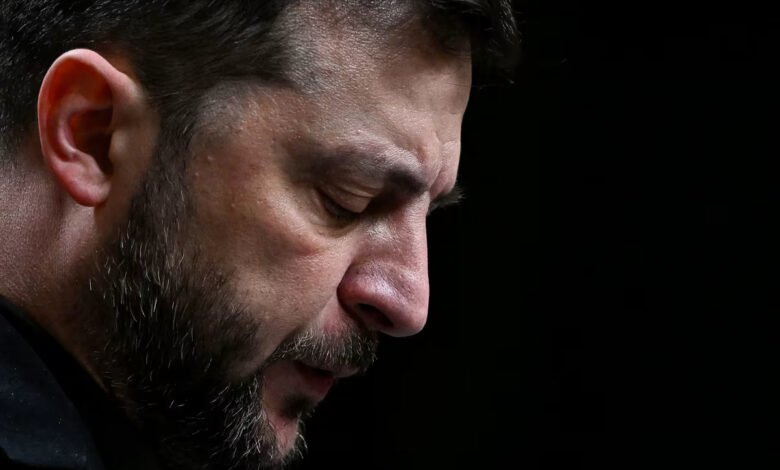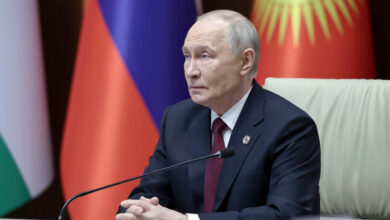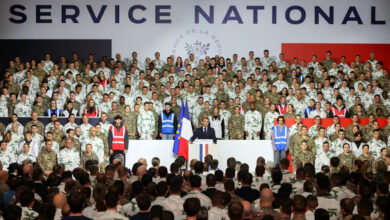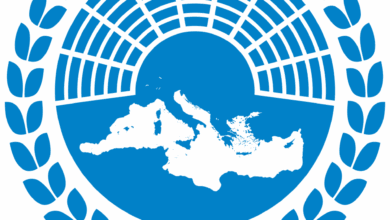
US President Donald Trump has stepped back from his Thanksgiving deadline for a deal in Ukraine, despite his urge to be seen as the peacemaker.
It is a key signal the coming denouement of his peace initiative – now a meeting in Moscow between his envoy Steve Witkoff and the Kremlin – will likely not yield a sudden deal to end Russia’s invasion.
The gaps between Kyiv and Moscow remain too explicit, and their reasons for obstinacy too drenched in sacrifice, anxiety and blood. Russian President Vladimir Putin’s reluctance to accept any proposal that does not leave him in control of all of Ukraine’s eastern Donetsk region will likely remain clear over the coming days.
The latest US proposal headed his way apparently strips that key concession from the plan leaked last week, something neither Kyiv nor its European allies consider militarily or politically wise. Given the decade-long history of this war – Russia’s three invasions of Ukrainian territory, over years of diplomacy and deceit – there is justification to doubt Moscow’s sincerity.
This repetitive, cyclic failure to grasp the gulf between the two warring sides – hammered out in two separate negotiating tracks – is ultimately why progress always seems so close, yet also so unattainable. Negotiating one deal with Ukraine and then another with Russia, then hoping the two get close enough to hold, provides the tantalizing illusion of progress, but in practice leads nowhere. The sticking points stick.
Much of the proposed deal involves putative, theoretical ideas about future alliances, financing or limits. But like parts of memorandums past, these elements may morph into something more practical, or disappear entirely, in the months after any deal is signed.
Ukraine won’t need an army of 600,000, the limit proposed in the draft deal, if it truly sees peace. NATO membership will likely become less urgently needed, and less viable in peacetime, when Ukraine must demobilize and handle the economic nightmare of a post-war economy, with the damage that will do to its armed forces’ integrity.
Will Russia rejoin the G8? It may want to, but the idea of Putin shaking hands at a summit with the leaders of the European states that still despise him seems farfetched. Who will pay for Ukraine’s reconstruction? Any grasp of how opaque business can be in Russia and Ukraine will tell you that won’t be simple or transparent, whatever the scheme. These points in any deal are important to address, but may alter in first contact with reality.
The single most vital issue is whether any deal actually stops the war. And Ukraine’s President Volodymyr Zelensky is likely headed towards again having to grapple with a hideous trade-off. He must weigh the value of future security guarantees, formalized by the United States and Europe, against the real and inevitable damage that conceding Donetsk would do to his, and Ukraine’s, political and military standing. It is a bad choice if a deal sticks. There is no choice if, in the long term, as before, the Kremlin does not honor the deal.

But the immediate future does not bring better news. A myriad of crises envelope Zelensky’s government. President Donald Trump’s deadline has displaced from the headlines a corruption scandal that re-emerged Friday with the news that corruption investigators searched the home of his chief-of-staff and lead negotiator, Andriy Yermak.
Ukraine’s military has a manpower crisis. Funding from Kyiv’s European allies is in doubt next year, although the European Union recently said it thinks it can bridge the gap. And on the front lines, three separate crises are unfolding: Russia is moving fast in Zaporizhzhia, slowly but inevitably in Pokrovsk, Donetsk region, and forwards in Kupiansk, further to the north. Ukraine cannot fight this many fires with so few soldiers.
The remainder of Donetsk under Kyiv’s control is also imperiled this winter. The major military hub of Kramatorsk is already subject to Russian short-range drone attacks, as Moscow’s forces are close enough. Kyiv won’t be taking territory back from Russia any time soon. The calculus ahead for Kyiv and its allies is not when can they turn around the progress of the war, but rather, can they get the Russians to break first?

The tacit hope of Kyiv and its allies, perhaps a forlorn one, is that Ukraine can push Russia’s brutal waste of manpower, and its total economic focus on the war, to the limit, and see it crack. It is impossible to predict in societies as closed as Russia how far away collapse might be. The Wagner rebellion of 2023 seemed fantastical, until Yevgeny Prigozhin’s men were on the road to Moscow over a turbulent 72 hours. Ukraine’s troubles are more open, and they are acute.
The fight ahead for Zelensky is fraught with risk. Russia is better resourced and making serious advances on the ground. Ukraine’s fight is existential – it doesn’t have Moscow’s luxury of one day deciding it has had enough and stopping the onslaught. But the net impact of the last 10 months of lumbering, diplomatic confusion and whiplash have made an unthinkable deal closer to becoming possible.

The idea of Ukraine ceding land to Moscow in exchange for peace was openly derided by Kyiv and Europe earlier this year, and throughout the Biden administration. Now it has found its way into the first iteration of the Trump 28-point peace plan. It has vanished from the leaked European counterproposal, but evidently not from Putin’s maximalist wish list.
A cycle will surely now repeat itself. Trump’s special envoy Witkoff will likely hear once again during his visit to Moscow that Putin will not budge on his demand that Ukraine give up Donetsk in return for peace. Witkoff will communicate that to Trump. Zelensky will be pressured again, and another Thanksgiving-style deadline may ensue.




